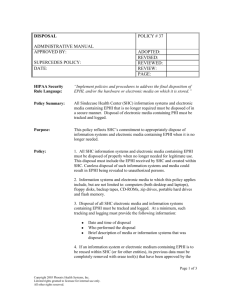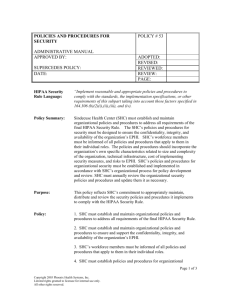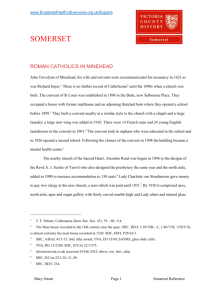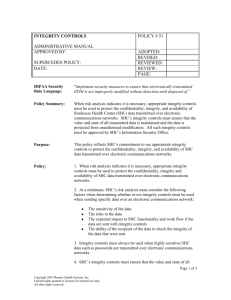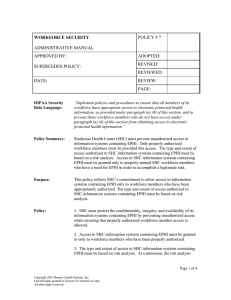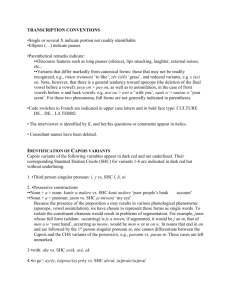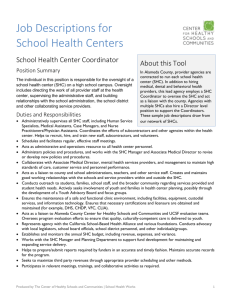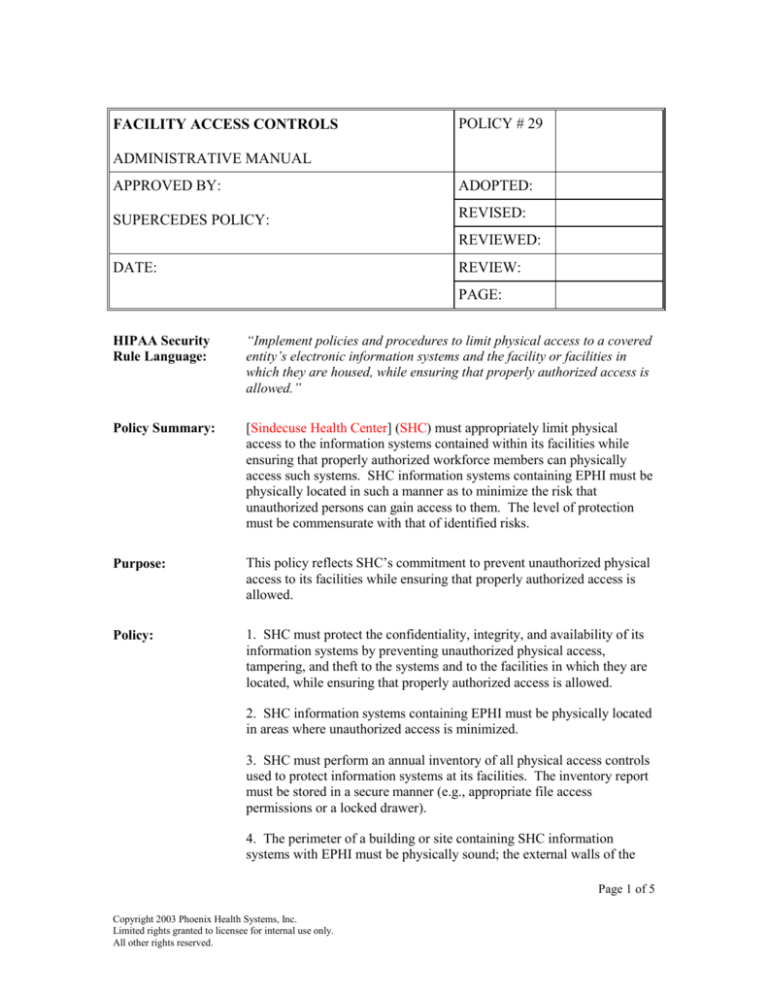
FACILITY ACCESS CONTROLS
POLICY # 29
ADMINISTRATIVE MANUAL
APPROVED BY:
ADOPTED:
SUPERCEDES POLICY:
REVISED:
REVIEWED:
DATE:
REVIEW:
PAGE:
HIPAA Security
Rule Language:
“Implement policies and procedures to limit physical access to a covered
entity’s electronic information systems and the facility or facilities in
which they are housed, while ensuring that properly authorized access is
allowed.”
Policy Summary:
[Sindecuse Health Center] (SHC) must appropriately limit physical
access to the information systems contained within its facilities while
ensuring that properly authorized workforce members can physically
access such systems. SHC information systems containing EPHI must be
physically located in such a manner as to minimize the risk that
unauthorized persons can gain access to them. The level of protection
must be commensurate with that of identified risks.
Purpose:
This policy reflects SHC’s commitment to prevent unauthorized physical
access to its facilities while ensuring that properly authorized access is
allowed.
Policy:
1. SHC must protect the confidentiality, integrity, and availability of its
information systems by preventing unauthorized physical access,
tampering, and theft to the systems and to the facilities in which they are
located, while ensuring that properly authorized access is allowed.
2. SHC information systems containing EPHI must be physically located
in areas where unauthorized access is minimized.
3. SHC must perform an annual inventory of all physical access controls
used to protect information systems at its facilities. The inventory report
must be stored in a secure manner (e.g., appropriate file access
permissions or a locked drawer).
4. The perimeter of a building or site containing SHC information
systems with EPHI must be physically sound; the external walls of the
Page 1 of 5
Copyright 2003 Phoenix Health Systems, Inc.
Limited rights granted to licensee for internal use only.
All other rights reserved.
FACILITY ACCESS CONTROLS
site should be solidly constructed and all external doors must have
appropriate protections against unauthorized access.
5. Physical barriers must, if necessary, be extended from actual floor to
actual ceiling to prevent unauthorized entry. Doors and windows should
be locked when unattended. External protection should be considered for
windows, particularly at ground level.
6. SHC delivery and loading areas must be controlled to prevent
unauthorized access. Where possible, the following controls must be
used:
Access to a holding area from outside of the building must be
restricted to identified and authorized persons.
The holding area must be designed so that supplies can be
unloaded without delivery staff gaining access to other parts of
the building.
The external door(s) of a holding area must be secured when the
internal door is opened.
7. The level of protection provided for SHC information systems
containing EPHI must be commensurate with that of identified risks. An
assessment of the risks to [Hospital Name] facilities and information
systems containing EPHI must be conducted at least annually.
8. The risk assessment report must place SHC information systems
containing EPHI into defined categories of risk such as:
Highly Sensitive – areas where large amounts of EPHI are stored
and maintained. Access to such areas requires security controls
such as card keys, visitor escort, and login sheets.
Sensitive – areas that have a high concentration of patients
and/or visitors and terminals which access EPHI. Security
controls used in these areas include locked closets and securely
located workstations.
The risk assessment report must be stored in a secure manner.
9. All physical access rights to SHC areas where information systems
containing EPHI are maintained must be clearly defined and documented.
Such rights must be provided only to [Hospital Name] workforce
members having a need for specific access in order to accomplish the
responsibilities of their positions.
10. All physical access rights to SHC areas where information systems
containing EPHI are maintained must be regularly reviewed and revised
as necessary.
11. All SHC workforce members must visibly wear the organization’s
Page 2 of 5
Copyright 2003 Phoenix Health Systems, Inc.
Limited rights granted to licensee for internal use only.
All other rights reserved.
FACILITY ACCESS CONTROLS
employee identification. Employees should be encouraged to report
unescorted strangers or anyone not wearing visible identification.
12. All visitors must show proper identification and sign in prior to
gaining physical access to SHC areas where information systems
containing EPHI are located.
13. As defined in SHC’s Contingency Operations policy, SHC must
have formal, documented procedures for allowing authorized workforce
members to enter its facilities to take necessary actions as defined in its
disaster recovery and emergency mode operations plans.
14. As defined in SHC’s Facility Security Plan policy, SHC must have
a facility security plan that details how it will protect its facilities and
equipment.
15. As defined in SHC’s Access Control and Validation Procedures
policy, SHC must implement procedures to control and validate
individuals’ access to SHC’s facilities based on their roles or functions.
16. As defined in SHC’s Maintenance Records policy, SHC must
document all repairs and modifications to the physical components of its
facilities that are related to security.
Scope/Applicability: This policy is applicable to all departments that use or disclose electronic
protected health information for any purposes.
This policy’s scope includes all electronic protected health information,
as described in Definitions below.
Regulatory
Category:
Physical Safeguards
Regulatory Type:
Standard
Regulatory
Reference:
45 CFR 164.310(a)(1)
Definitions:
Electronic protected health information means individually identifiable
health information that is:
Transmitted by electronic media
Maintained in electronic media
Electronic media means:
Page 3 of 5
Copyright 2003 Phoenix Health Systems, Inc.
Limited rights granted to licensee for internal use only.
All other rights reserved.
FACILITY ACCESS CONTROLS
(1) Electronic storage media including memory devices in computers
(hard drives) and any removable/transportable digital memory medium,
such as magnetic tape or disk, optical disk, or digital memory card; or
(2) Transmission media used to exchange information already in
electronic storage media. Transmission media include, for example, the
internet (wide-open), extranet (using internet technology to link a
business with information accessible only to collaborating parties), leased
lines, dial-up lines, private networks, and the physical movement of
removable/transportable electronic storage media. Certain transmissions,
including of paper, via facsimile, and of voice, via telephone, are not
considered to be transmissions via electronic media, because the
information being exchanged did not exist in electronic form before the
transmission.
Information system means an interconnected set of information resources
under the same direct management control that shares common
functionality. A system normally includes hardware, software,
information, data, applications, communications, and people.
Workforce member means employees, volunteers, and other persons
whose conduct, in the performance of work for a covered entity, is under
the direct control of such entity, whether or not they are paid by the
covered entity. This includes full and part time employees, affiliates,
associates, students, volunteers, and staff from third party entities who
provide service to the covered entity.
Availability means the property that data or information is accessible and
useable upon demand by an authorized person.
Confidentiality means the property that data or information is not made
available or disclosed to unauthorized persons or processes.
Integrity means the property that data or information have not been
altered or destroyed in an unauthorized manner.
Facility means the physical premises and the interior and exterior of a
building(s).
Access means the ability or the means necessary to read, write, modify, or
communicate data or otherwise use any system.
Responsible
Department:
Building coordinator; Information Systems
Policy Authority/
Enforcement:
SHC’s Security Official is responsible for monitoring and enforcement of
this policy, in accordance with Procedure # (TBD).
Page 4 of 5
Copyright 2003 Phoenix Health Systems, Inc.
Limited rights granted to licensee for internal use only.
All other rights reserved.
FACILITY ACCESS CONTROLS
Related Policies:
Contingency Operations
Facility Security Plan
Access Control and Validation Procedures
Maintenance Records
Renewal/Review:
This policy is to be reviewed annually to determine if the policy complies
with current HIPAA Security regulations. In the event that significant
related regulatory changes occur, the policy will be reviewed and updated
as needed.
Procedures:
TBD
Page 5 of 5
Copyright 2003 Phoenix Health Systems, Inc.
Limited rights granted to licensee for internal use only.
All other rights reserved.


